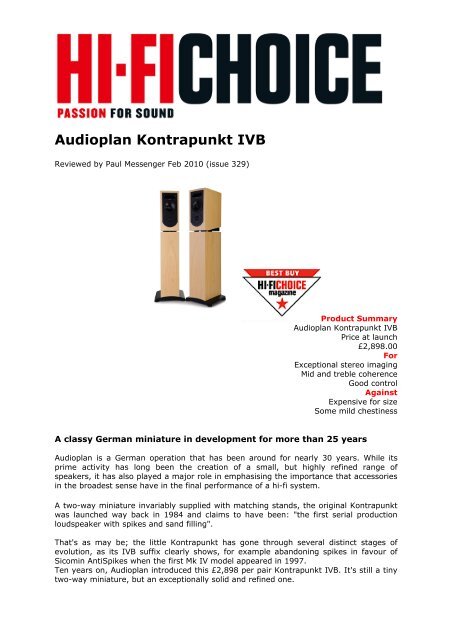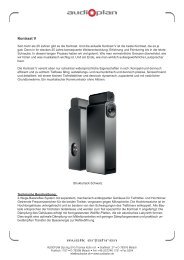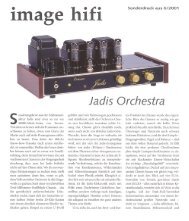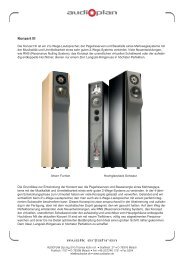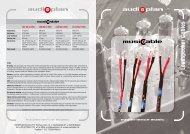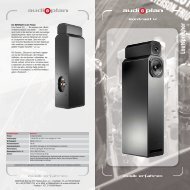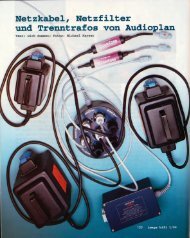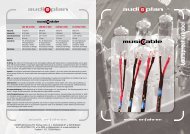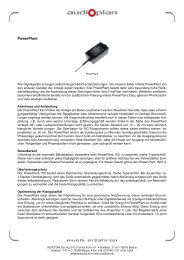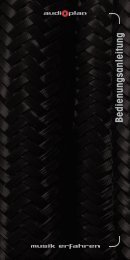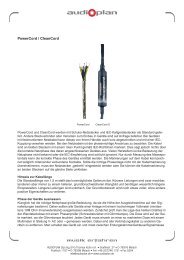Audioplan Kontrapunkt IVB
Audioplan Kontrapunkt IVB
Audioplan Kontrapunkt IVB
Create successful ePaper yourself
Turn your PDF publications into a flip-book with our unique Google optimized e-Paper software.
<strong>Audioplan</strong> <strong>Kontrapunkt</strong> <strong>IVB</strong><br />
Reviewed by Paul Messenger Feb 2010 (issue 329)<br />
Product Summary<br />
<strong>Audioplan</strong> <strong>Kontrapunkt</strong> <strong>IVB</strong><br />
Price at launch<br />
£2,898.00<br />
For<br />
Exceptional stereo imaging<br />
Mid and treble coherence<br />
Good control<br />
Against<br />
Expensive for size<br />
Some mild chestiness<br />
A classy German miniature in development for more than 25 years<br />
<strong>Audioplan</strong> is a German operation that has been around for nearly 30 years. While its<br />
prime activity has long been the creation of a small, but highly refined range of<br />
speakers, it has also played a major role in emphasising the importance that accessories<br />
in the broadest sense have in the final performance of a hi-fi system.<br />
A two-way miniature invariably supplied with matching stands, the original <strong>Kontrapunkt</strong><br />
was launched way back in 1984 and claims to have been: "the first serial production<br />
loudspeaker with spikes and sand filling".<br />
That's as may be; the little <strong>Kontrapunkt</strong> has gone through several distinct stages of<br />
evolution, as its <strong>IVB</strong> suffix clearly shows, for example abandoning spikes in favour of<br />
Sicomin AntiSpikes when the first Mk IV model appeared in 1997.<br />
Ten years on, <strong>Audioplan</strong> introduced this £2,898 per pair <strong>Kontrapunkt</strong> <strong>IVB</strong>. It's still a tiny<br />
two-way miniature, but an exceptionally solid and refined one.
The speaker itself weighs a surprisingly hefty 9.4 kilograms, but that pales into<br />
insignificance when you try to lift the matching pedestal stand, which totals 29 kilograms<br />
(including 20 kilograms of sand fill). It's almost as though the pedestal 'raises the floor'<br />
to support the speaker proper, although it's apparently possible to adjust the tonality by<br />
varying the amount of sand.<br />
It's a very pretty loudspeaker (and pedestal), with a choice of four real-wood veneers –<br />
cherry, beech, maple and apricot – or four paint finishes (grey, white and black enamel,<br />
and black high gloss). It's also very heavily built, with walls up to 65 millimetres thick.<br />
Heavy duty twin terminal pairs, plus substantial silver-plated links, feed an encapsulated<br />
crossover. The small main driver has an 80-millimetre doped paper cone and is mounted<br />
above a mechanically decoupled 25-millimetre fabric dome tweeter and below a slotshaped<br />
port.<br />
The AntiSpike coupling consists of small discs, about three centimetres in diameter and a<br />
few millimetres thick, which sit on three similar looking discs recessed into the top<br />
surface of the pedestal.<br />
The base of the pedestal has a small plinth which extends the stability footprint and<br />
again sits on AntiSpikes – four in this case.<br />
Sound quality<br />
Tiny loudspeakers are bound to lack bass weight and loudness capability, but they also<br />
have significant advantages in several areas.
Small enclosures are bound to produce similarly small cabinet coloration, and their wide<br />
dispersion promotes good imaging; small main drivers operate higher into the upper<br />
midrange without difficulty and integrate better with a tweeter.<br />
And it's the quite wonderful stereo image, precision and focus that really sets this small<br />
speaker apart from the herd. The above reasons do indeed contribute, but such<br />
advantages can only be as good as the specific implementation.<br />
It's abundantly clear that this model's painstaking long-term development, and its<br />
consequent excellent coherence and very low levels of coloration, make a major<br />
contribution to its superior imaging.<br />
Although deep bass isn't on the agenda here, and the lower mid sounds a little lean,<br />
there's sufficient port-assisted midbass to keep the speaker well clear of walls and thus<br />
add air and spaciousness to the imaging.<br />
There's also a touch of chestiness through the lower registers, but the mid and presence<br />
voicing and coherence are about as good as it gets and are more than fair compensation.<br />
Paul Messenger<br />
HiFiChoice<br />
Feb 2010


